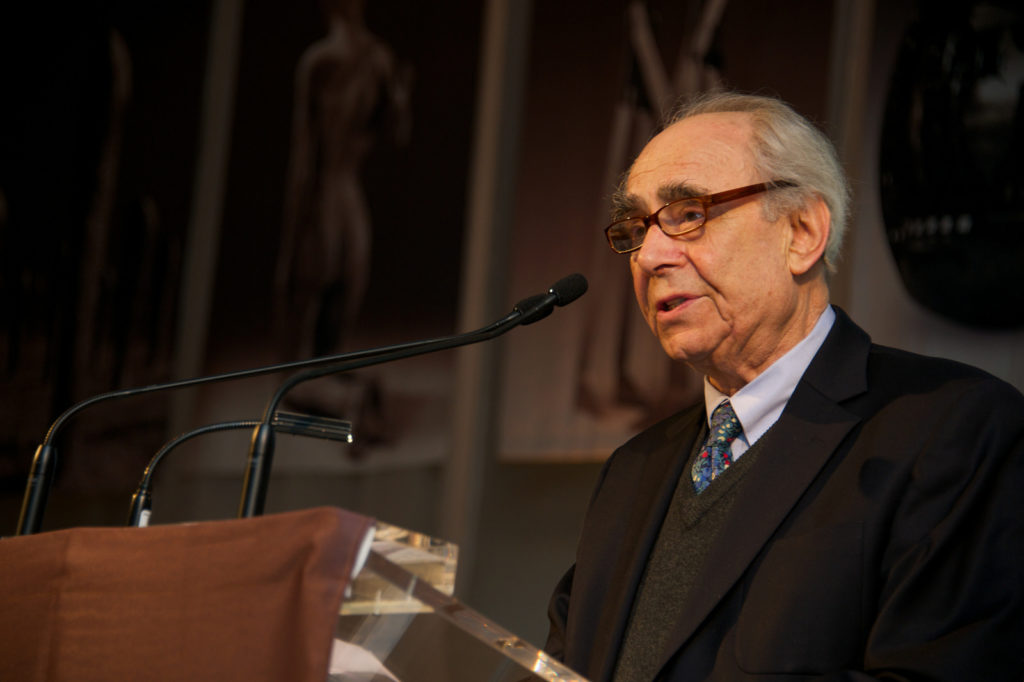People
Irving Sandler, the Zelig-Like Art Critic Who Immortalized His Famous Friends in Art History, Has Died
Sandler chronicled the rise of Abstract Expressionism in New York with unrivaled intimacy.

Sandler chronicled the rise of Abstract Expressionism in New York with unrivaled intimacy.

Javier Pes

The scholar and critic Irving Sandler (1925–2018), who chronicled the rise of American Abstract Expressionism and became known for his ability to turn close personal relationships with artists into dynamic fodder for art history books, has died. He was 92.
“No one has seen more exhibitions in New York galleries or sat on, or in on, as many panels for as many years,” Robert Storr, a fellow critic and prolific interviewer of artists, wrote of Sandler in Artforum in 2004. “Nor has anyone more scrupulously set down what people said in such forums, at openings, or in intimate studio or bar conversations than Sandler.”
A former marine, Sandler attended Temple University on the G.I. bill and later received a master’s degree in American studies from the University of Pennsylvania. He had been infatuated with art since a fateful encounter with a painting by Franz Kline at the New York’s Museum of Modern Art in 1952, when he was working toward a doctorate in American history at Columbia University.
But he discovered early on in his career that he was not cut out to be a gallerist. In 1956, he became the manager of the artist-run Tanager Gallery on East 10th Street. But, he recalled, he sold only one work in three years. In 1972, he went on to co-found the New York nonprofit Artists Space, which became—and remains—a hub for ambitious and not-always-commercial projects by artists.
His first book, The Triumph of American Painting: A History of Abstract Expressionism, published in 1970, has become a touchstone for our understanding of the movement that defined New York—and American—art for decades. Sandler’s scholarship was distinguished by two elements: The fact that it was built on interviews and close friendships with the artists he studied and the fact that, unlike his peers Clement Greenberg or Harold Rosenberg, he wasn’t arguing for certain artists’ superiority over others—he was merely documenting a moment in history.
Looking back on the period in 2013, Sandler told the academic and fellow Ab-Ex expert Joan Marter that there were two groups of artists in New York in the 1950s. “There was an uptown group: Robert Motherwell, Barnett Newman, Mark Rothko, Jackson Pollock when he came into town, and David Smith.” The uptown group “lived in apartments and socialized over dinner.” And then there was the downtown group, “who lived in and associated at the Cedar Street Tavern and The Club.”
Sandler knew them all—as well as their gallerists, such as Betty Parsons and Charles Egan—and was on the spot when the action happened. He told Mater about one particularly delightful night at the Cedar Street Tavern when Elaine de Kooning arrived with a boxing champion in tow.
“Ezzard Charles… nine feet tall. Beautiful man. [The artist] Herman Cherry, who stood about five feet tall, begins to tell Charles about action painting. ‘You know Mr. Charles, it’s like boxing. You make a move and the canvas moves back,’ and he begins sparring around Charles. Shadowboxing. And Ezzard Charles listens very carefully to Cherry and he says, ‘I understand what you’re saying, but the canvas don’t hit back, do it?’ It was a real scene.”
Sandler went on to write The New York School: The Painters and Sculptors of the Fifties (1978); American Art of the 1960s (1988), and Art of the Postmodern Era: From the Late 1960s to the Early 1990s (1996). In addition to his books, Sadler also wrote criticism. He was ARTnews’s senior critic from 1956 to 1962 and a critic at the New York Post and Art in America.
His memoir, A Sweeper-Up After Artists (2004), took its title from fellow New York critic and poet Frank O’Hara’s description of Sandler as “the balayeur des artistes.” The historian’s final book, From Avant-Garde to Pluralism: An On-the-Spot History (2006), summed up the experience of having a ringside seat to New York’s art world for more than six decades.
Looking back over his career, he wrote: “The thread that runs through my writing is a concern for the intentions, visions, and experiences of artists.”